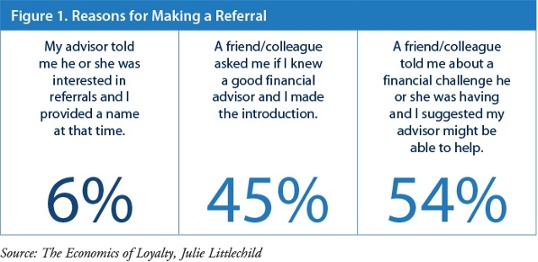Gaining Introductions to High-Quality Prospects: 4 Common Questions
by Commonwealth Financial Network
 According to ClientWise, elite advisors gain more than 70 percent of their new clients through introductions, and the Oechsli Institute found that high-net-worth people prefer to be introduced to their advisor by someone they trust. So, if there’s one skill you should master for production growth, it’s gaining introductions to high-quality prospects.
According to ClientWise, elite advisors gain more than 70 percent of their new clients through introductions, and the Oechsli Institute found that high-net-worth people prefer to be introduced to their advisor by someone they trust. So, if there’s one skill you should master for production growth, it’s gaining introductions to high-quality prospects.
Easier said than done, right? Not necessarily. Here, we’ll look at four common questions advisors ask about getting referrals, along with solutions for overcoming perceived challenges.
Yes, you should talk to your clients regularly about people you can help. But you shouldn’t ask for referrals; you should ask for introductions. Getting a prospect’s name as a referral is only the beginning of a slow acquisition process, and its value can often be ambiguous. So, be clear about what you want, and ask to be introduced to someone specific.
Over the years, several advisors have called me to discuss why their long-term A clients rarely, if ever, give referrals—and what they can do about it. My advice? Simply ask.
First, ask your client if he or she is happy with the work you’ve done (and wait for the compliments that will likely follow). Then, ask the key question: “If that’s the case, why haven’t you ever referred someone else to the practice?” In my experience, many clients say that they simply didn’t know the advisor had been looking for more clients and, once they did know, were happy to introduce prospects.
So, do your clients know that you’d like introductions? Here are a few simple ways to let them know:
- Tell clients, simply and directly.
- Add a bullet point to client agendas.
- Add a line to your e-mail signature.
- Train staff on what to say to clients.
Of course, you'll need to find what works for you. Just be sure to make it a priority, or you’ll find yourself looking back, thinking about missed revenue opportunities.
According to the Economics of Loyalty, when asked about referrals, clients said that, in most cases, the referral resulted from a conversation with a friend or colleague—not with the advisor. That is, clients don’t give referrals to help you; they give them to help other people (see Figure 1).

Once you understand that referrals or introductions come when clients want to help other people, you can start to find the words and situations that will act as a catalyst for people to suggest you. I call these “lightbulb moments,” and your goal is to ensure that clients leave your office with very specific ideas about who your ideal client is and when they can refer those prospects to you.
For example, if you work with retirees, you could end a client meeting with the following:
Bill, I’m so glad that you have the income you need to live comfortably in retirement. I know that people without a good retirement income plan in place are often worried. The next time you’re golfing at the country club, and you hear friends talking about how low interest rates are hurting their income, remember that I’d be happy to help them for you.
You’ve stated the value that the client has received from working with you; be sure to do that first. You’ve also primed the client to be ready for a specific occasion when he has an opportunity to mention you. In this case, the occasion is a discussion of low interest rates (a fairly common concern among retirees), and the opportunity is at the country club (typically with affluent people). When your client next goes golfing and someone complains about interest rates, the client will hopefully remember your conversation, and then the lightbulb moment (you need to talk with my advisor) will occur.
Here’s another example, for business owners:
Sue, I’m glad we set up a retirement plan for your business. Not only will you save thousands in taxes, you and your employees will be able to save for retirement in a tax-efficient way [value]. And having a retirement plan helps you attract good talent, as well as retain it. When you’re at the next Chamber of Commerce meeting, and you hear business owners complaining that taxes are killing them [occasion], think of me. I’d be happy to be a resource to any of your business colleagues [opportunity].
What these examples boil down to is letting clients know the people you help and the problems you solve. When you talk about this regularly, clients will better understand who would be a good fit for your practice. Often, advisors don’t know their ideal client; I hear things like, “older clients with at least $500,000 in investable assets who like to delegate.” That might be true, but it’s virtually impossible to search for and unrealistic to expect clients to find. This exercise might force you to think through it yourself, which is a good thing.
Advisors ask this fairly often. It puzzles me why they would spend time and money on something that is almost guaranteed to fail. It doesn’t work because advisors almost always use generic language. If you can’t target your message to reach your ideal prospects, it’s not going to be effective.
More important, you don’t need to prospect this way. You’ve now learned how to prime clients to look for prospects for you: letting your clients know who your ideal prospects are and giving them those lightbulb moments.
Also (as I talk about in yesterday’s post), you’ve got the best prospecting database in the business—LinkedIn—at your fingertips, free and ready for you to use. LinkedIn makes it easy; when you see “2nd Connection” after a prospect’s name, it means you are connected to someone who can introduce you:
Kim, I was on LinkedIn and I see that you are connected to Dr. Smith, who also works at the hospital. I’ve seen her around town but never had the chance to meet her. Do you think you could arrange for us all to have coffee one morning?
More than likely, your client will be happy to introduce you. And you now have a qualified prospect who might need your services.
One of the surest signs of growth is a continual stream of new clients. The introduction strategies and tactics discussed here are designed to help you achieve just that. But there’s one more thing you need to do: keep track of your progress.
Do you know how many new clients you added in 2015? How about so far in 2016? Be sure to track this on a regular basis and set goals for new client acquisition. By creating realistic and stretch goals for both introductions and new clients, you’ll help keep introductions top of mind.
What strategies do you use to gain introductions? How do you let your clients know you’re interested in referrals? Please share your thoughts with us below!
Commonwealth Financial Network is the nation’s largest privately held independent broker/dealer-RIA. This post originally appeared on Commonwealth Independent Advisor, the firm’s corporate blog.
Copyright © Commonwealth Financial Network
















